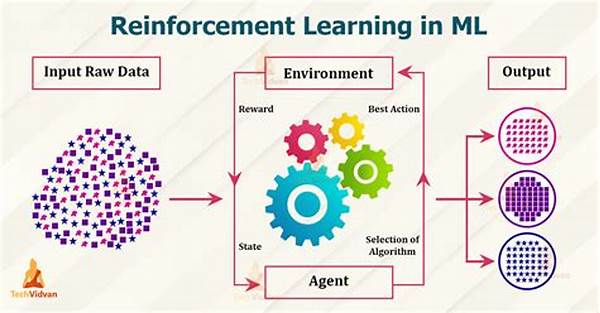Hey there, fellow gamer and tech enthusiast! Have you ever wondered how games get so good at anticipating your next move or why some in-game opponents feel almost human-like in their decision-making? Well, buckle up because we’re diving into the fascinating world of reinforcement learning algorithms in gaming. Imagine a virtual character that learns and adapitates over time, offering a dynamic challenge instead of static, predictable behavior. Sounds exciting, right? Let’s explore how these algorithms are changing the gaming landscape.
Read Now : Elevating Gameplay Realism With Physics
How Reinforcement Learning is Changing the Game
Picture this: You’re playing your favorite game, and suddenly the AI opponents start adopting strategies similar to seasoned human players. That’s the magic of reinforcement learning algorithms in gaming. These algorithms enable games to observe player behavior, adapt accordingly, and effectively respond with more context-aware, challenging gameplay. Instead of a predetermined set of reactions from game AI, reinforcement learning allows for a continuously evolving experience, making each playthrough unique and thrilling. Game developers are excited to implement these intelligent systems that go beyond traditional gaming mechanics, offering a richer and more immersive environment. From action-packed shooters to strategic board games, reinforcement learning promises a frontier where AI isn’t just an opponent, but a learning entity, offering fresh experiences with every encounter. The possibilities seem endless, and the excitement is palpable as games push the envelope of AI integration.
The Mechanics Behind Reinforcement Learning Algorithms
1. Trial and Error: At the core of reinforcement learning algorithms in gaming is trial and error. The AI learns by trying different actions and understanding which yield the best results—a bit like how we humans learn from experience.
2. Rewards System: It’s all about rewards. The algorithm receives ‘points’ for beneficial actions, encouraging it to repeat those actions in future scenarios to maximize its score.
3. Exploration vs. Exploitation: The AI must choose between exploiting known winning strategies or exploring new ones, balancing experimentation and strategy to constantly evolve its gameplay.
4. Continuous Improvement: Reinforcement learning thrives on constant feedback and adjustment, allowing AI to refine its strategies progressively, which keeps the gameplay fresh and challenging.
5. Environment Interaction: These algorithms thrive on interaction with the gaming environment, learning the intricacies of the virtual world to better adapt and make informed decisions.
The Appeal of Reinforcement Learning in Multiplayer Games
So, you love battling it out in multiplayer arenas? Reinforcement learning algorithms in gaming have got something special for you. These smart systems can enhance the gaming experience by creating more balanced matches and reducing unfair advantages. Imagine playing against an AI that analyzes your techniques in real-time, forcing you to come up with innovative tactics. Intriguing, right? Not only does it offer a unique learning experience, but it also raises the competitive spirit, pushing players to outsmart adaptive opponents rather than just executing muscle memory moves. Whether you’re a casual gamer or a competitive junkie, the dynamic nature of these algorithms in multiplayer games ensures the thrill never fades. And for developers, this means crafting AI that can compete, learn, and adapt alongside human players, enriching the multiplayer experience and setting a new standard for what players expect from game AI.
Read Now : **adaptive Soundtracks For Gameplay**
Challenges in Implementing Reinforcement Learning
While the prospect of implementing reinforcement learning algorithms in gaming is exciting, it’s not without challenges. Developing AI that can intelligently adapt requires significant computational resources and creativity from developers. Furthermore, ensuring the AI doesn’t become too hard to defeat or predictably easy poses a delicate balancing act. Then there’s the challenge of integrating these AI systems with existing game frameworks without negatively impacting performance. Developers are working tirelessly to overcome these hurdles, investing in smarter algorithms and robust testing environments. Additionally, as these algorithms become more prevalent, ethical considerations around fairness, inclusivity, and user privacy will also need to be addressed. While the road ahead is complex, the potential rewards make these challenges worth tackling, promising an elevated gaming experience for players around the globe.
The Future of AI in Gaming
As games continue to evolve, the role of reinforcement learning algorithms in gaming will only grow more significant. We’re on the brink of an era where AI opponents aren’t just programmed entities but are capable of learning, adapting, and growing, much like their human counterparts. This shift could profoundly change how games are developed and experienced. Players could enter worlds where every session offers unique challenges and opportunities to learn, pushing their skills to new heights. Meanwhile, developers could create games that keep players engaged longer through emergent gameplay and infinitely replayable scenarios. As we look to the future, one thing is clear: reinforcement learning will redefine what it means to play and compete in digital spaces.
Final Thoughts on Reinforcement Learning in Gaming
In wrapping up our exploration of reinforcement learning algorithms in gaming, it’s clear that this innovative AI application offers unparalleled potential to revolutionize player experiences. By creating adaptive AI that learns and evolves, game designers can craft more engaging and challenging environments that keep us gamers on our toes. While there are hurdles to overcome, particularly in terms of resources and ethical considerations, the benefits are too significant to ignore. Whether you’re a casual player or a hardcore gamer, prepare for a future where games are not only more immersive but also more intellectually stimulating, thanks to these brilliant algorithms.
Wrapping Up
So there you have it—a glimpse into the exciting world of reinforcement learning algorithms in gaming! These advanced systems have the power to change the way we interact with games, turning static playthroughs into dynamic, ever-evolving experiences. By enabling AI to learn from and respond to player actions, developers can create richer, more engaging virtual worlds. From challenging AI opponents in your favorite titles to crafting entirely new gaming genres, the possibilities are truly endless. As we embrace this technology, it will be thrilling to see how games continue to evolve, offering experiences that are fresh, challenging, and endlessly replayable. Whether you’re a player eager for new challenges or a developer pushing the boundaries of what’s possible, the future of gaming, driven by reinforcement learning, is brighter than ever.





